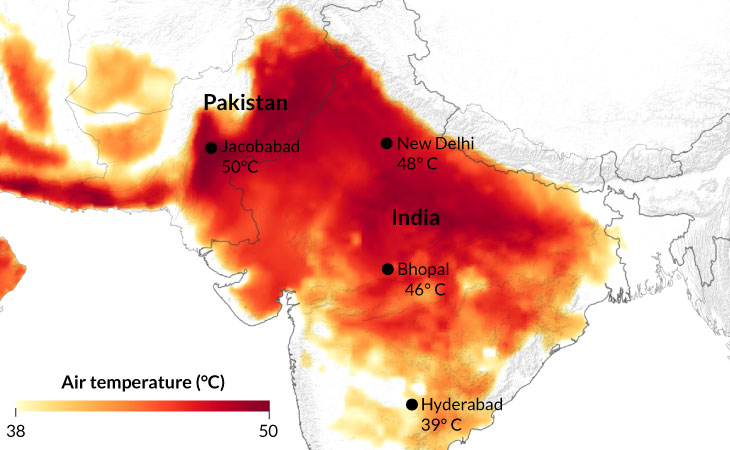Is climate change causing Europe’s intense heat? A scientist weighs in
Karsten Haustein talks about what is driving extreme heat in Europe and South Asia

SUN SHELTER A brief, but intense, heat wave is baking much of mainland Europe, including Paris, shown in this photograph taken June 26. Researchers are working to determine how this heat wave might be linked to human-caused climate change.
KENZO TRIBOUILLARD/AFP/Getty Images
- More than 2 years ago
Mainland Europe has sweltered for days under record-breaking temperatures, prompting researchers to try to untangle how much of the heat wave can be linked to climate change. A report on that, by an international consortium of scientists called the World Weather Attribution Network, is expected to be released on July 2.
Previous heat records for many parts of Europe were set in the summer of 2003, when temperatures soared to 44.1° Celsius (111.4° Fahrenheit) in the southern French town of Conqueyrac. That extreme heat killed more than 70,000 people across the continent — a death toll that researchers determined was amplified by climate change (SN: 9/3/16, p. 5).
As another heat wave in 2018 baked Europe for three months, the consortium conducted a rapid assessment that determined it could not have happened without anthropogenic, or human-caused, climate change. Such events could occur yearly if global temperatures rise 2 degrees Celsius above pre-industrial levels by 2100, the researchers found. If global warming is limited to 1.5 degrees Celsius, though, such events were predicted every two out of three years.
This year’s event, which began in mid-June, is expected to be shorter. But it is intense. On June 28, temperatures in Gallargues-le-Montueux, a city in southern France, hit 45.9° C (114.6° F), smashing temperature records for the country.
But Europe isn’t the only part of the world dealing with dangerous heat levels. India and Pakistan have been suffering since mid-May under one of the longest-lasting heat waves in its recent history. In June, temperatures in New Delhi soared to 48° C (118.4° F), the highest ever recorded for the month in the Indian capital. By June 21, at least 180 people reportedly had died from heat-related causes.
Science News spoke with Karsten Haustein, a climate scientist at the University of Oxford in England who is affiliated with the consortium, about what’s behind these deadly events and how scientists determine in real time whether a particular heat wave can be attributed to climate change. His comments have been edited for clarity and brevity.
SN: Why was the World Weather Attribution Network created?
Haustein: The idea was that we would look at any given extreme events while they’re happening and try to scientifically attribute the climate change factor. For example, has it become a more likely event or not [due to climate change]? We define the event, put it into historic context — for example, is it a 1-in-100-year event? — and determine if it’s setting records or getting media attention. And then we do the model analyses to isolate the climate signal. We’re also teaching other researchers, in places including Kenya, South Africa and Australia, how to use our methods.
SN: Why are you analyzing the current Europe heat wave?
Haustein: This current heat wave just started 10 days ago. [By June 24], it was already shaping up to be pretty extreme, so we went for it.
The all-time maximum temperature in France was 44.1° C, from August 2003. That was a really bad one. There are chances we’ll get up to 45° C, which would be quite a new record. [A few hours after this interview, that milestone was reached on June 28.] For June, that’s pretty epic. Germany’s temperatures will peak on Sunday [June 30], and probably Monday [July 1] in Austria. And then there are two cold fronts that will be pushing through.
SN: What atmospheric conditions are causing the intense heat?
Haustein: To get a heat wave going, you need warm air in the upper level [of the atmosphere]. That comes from the south, from Africa. We actually set a record [on June 27] for temperatures at 1.5 kilometers above Earth’s surface, reaching 25.5° C.
How those upper-level air masses translate into temperatures on the surface is a different story. In simple terms, the jet stream where it sits across Europe divides colder air in the north from warmer air in the south. Sometimes [this fast current of air above the Northern Hemisphere] becomes very wiggly, with big loops going far to the north and all the way down to northern Africa. That can transport really hot air from Africa to Europe. If it sits over Europe for several days, it can heat the surface.
What’s causing that wiggly jet stream is contentious. Some people have suggested it’s linked to increasing temperatures in the Arctic. But we don’t really know. All we can say is that, over the last 10 days, there’s been a tendency to have this pattern: We see the jet stream digging farther south, and Europe is sitting in this warm air.
Blistering heat
Extreme temperatures scorched much of India and Pakistan from mid-May through June 2019. NASA’s Goddard Earth Observing System, a global atmospheric climate simulation, created this map of air temperatures across the region on June 10. Several factors contributed to the heat wave, including a delayed monsoon. The health impacts of South Asia’s rising temperatures are unclear, though, due to other factors that can impact health, including higher humidity and air pollution levels in the region. And it’s also not yet clear if the region has been seeing an overall trend of increasing maximum air temperatures since the 1970s.

SN: What about the heat wave in South Asia?
Haustein: As far as climate attribution, it’s similar to work we did on the 2016 heat wave in India. [That heat wave included a record-breaking temperature of 51° C in the western state of Rajasthan.] India’s 2019 temperatures appear to be due to natural year-to-year variability. We did a brief analysis that found that maximum temperatures across India in the hottest months aren’t clearly increasing.
SN: What did the consortium learn in analyzing the 2018 European heat wave?
Haustein: We know that the frequency and intensity of heat waves are increasing globally. Heat waves in Europe, such as the one in 2018, are at least twice as likely to occur now as a result of climate change.






